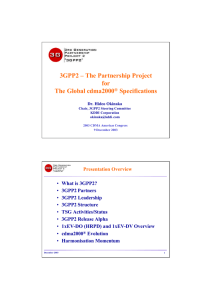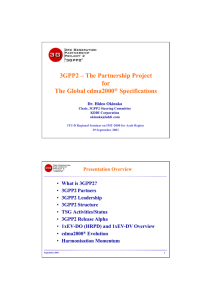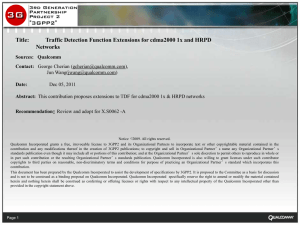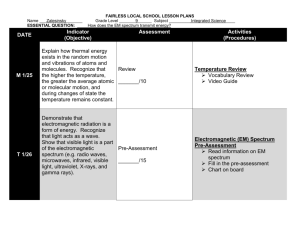Introduction to cdma2000 Standards for Spread Spectrum Systems
advertisement
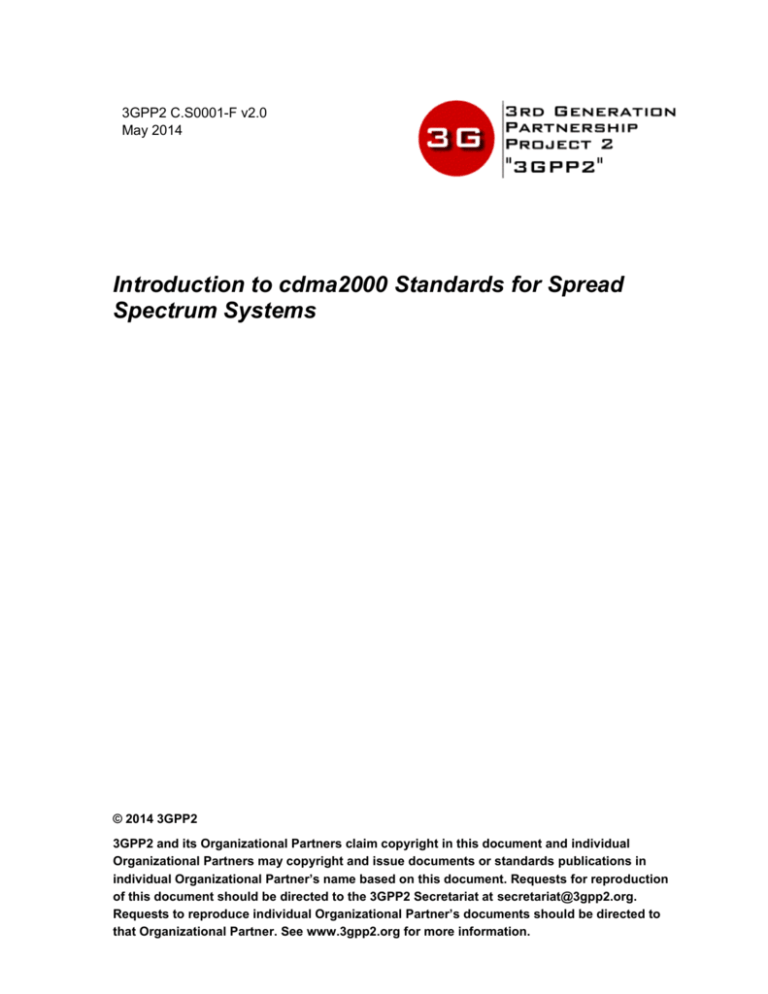
3GPP2 C.S0001-F v2.0 May 2014 Introduction to cdma2000 Standards for Spread Spectrum Systems © 2014 3GPP2 3GPP2 and its Organizational Partners claim copyright in this document and individual Organizational Partners may copyright and issue documents or standards publications in individual Organizational Partner’s name based on this document. Requests for reproduction of this document should be directed to the 3GPP2 Secretariat at secretariat@3gpp2.org. Requests to reproduce individual Organizational Partner’s documents should be directed to that Organizational Partner. See www.3gpp2.org for more information. 3GPP2 C.S0001-F v2.0 Revision History Revision Description of Changes Date Rev. 0 v1.0 Initial publication October 1999 Rev.0 Addendum 2 v1.0 Addendum May 2001 Rev. 0 v3.0 Bug fix July 2001 Rev. A v1.0 Revision July 2000 Rev. A v5.0 Bug fix July 2001 Rev. B v1.0 Revision April 2002 Rev. C v1.0 Revision May 2002 Rev. C v2.0 Bug fix August 2004 Rev. D v1.0 Revision March 2004 Rev. D v2.0 Bug fix October 2005 Rev. E v1.0 Revision September 2009 Rev. E v2.0 Bug fix June 2010 Rev. E v3.0 Bug fix June 2011 Rev. F v1.0 Revision December 2012 Rev. F v1.1 Bug fix baseline (Note: There is no change in this volume. Republished with other volumes) December 2013 Rev. F v1.2 Bug fix V&V (Note: Made minor editorial modifications. Republished with other volumes) March 2014 3GPP2 C.S0001-F v2.0 CONTENTS 1 2 1 OVERVIEW .............................................................................................................. 1-1 1.1 3 The cdma2000 Family of Standards .................................................................... 1-1 4 1.1.1 Scope ........................................................................................................... 1-1 5 1.1.2 Architecture ................................................................................................. 1-2 6 1.2 Relationship to TIA/EIA-95-B ............................................................................. 1-5 7 1.3 Requirements Terminology ................................................................................. 1-5 8 1.4 References ......................................................................................................... 1-6 9 1.5 Informative References ....................................................................................... 1-7 10 1.6 Support of Multiple Band Classes ....................................................................... 1-8 11 12 2 COMMON ASPECTS................................................................................................. 2-1 2.1 Channel Naming Conventions ............................................................................. 2-1 13 2.1.1 Logical Channel Naming Convention ............................................................. 2-1 14 2.1.2 Physical Channel Naming Convention ........................................................... 2-1 15 2.2 Definitions of Terms ........................................................................................... 2-2 16 2.3 Constants .......................................................................................................... 2-2 17 18 FIGURES 19 Figure 1 cdma2000 Architecture ................................................................................... 1-2 20 Figure 2 cdma2000 Architecture (Mobile Station) ............................................................. 1-3 21 Figure 3 cdma2000 Architecture (Base Station) .............................................................. 1-4 22 23 TABLES 24 Table 1. Naming Conventions for Logical Channels ........................................................ 2-1 25 Table 2. Physical Channel Names ................................................................................. 2-1 26 Table 3. cdma2000 Constants ...................................................................................... 2-2 27 28 i 3GPP2 C.S0001-F v2.0 1 This page intentionally left blank. ii 3GPP2 C.S0001-F v2.0 1 FOREWORD 2 (This foreword is not part of this Specification) 3 4 5 6 7 8 9 10 11 This Specification was prepared by Technical Specification Group C of the Third Generation Partnership Project 2 (3GPP2). This Specification contains the Introduction to the IMT-2000 CDMA Multi-Carrier Mode, IMT-2000 CDMA MC, also known as cdma2000®1. It provides a specification for land mobile wireless systems based upon cellular principles. This Specification includes the capabilities of Telecommunications Industry Association Standard TIA/EIA-95-B. This Specification provides the Introduction to the IMT-2000 CDMA MC air interface; however, other specifications are required to complete the air interface and the rest of the system. Some of these specifications are listed in the References section. 12 1cdma2000® is the trademark for the technical nomenclature for certain specifications and standards of the Organizational Partners (OPs) of 3GPP2. Geographically (and as of the date of publication), cdma2000 ® is a registered trademark of the Telecommunications Industry Association (TIA-USA) in the United States. iii 3GPP2 C.S0001-F v2.0 1 This page intentionally left blank. iv 3GPP2 C.S0001-F v2.0 1 1 2 1.1 3 4 5 6 7 8 9 10 11 12 13 14 15 16 17 18 19 20 21 22 23 24 25 26 27 28 29 30 31 32 33 34 35 36 37 38 OVERVIEW The cdma2000 Family of Standards The cdma2000 family of standards includes core air interface, minimum performance, and service standards (see section 1.3). The cdma2000 air interface standards specify a spread spectrum radio interface that uses Code Division Multiple Access (CDMA) technology to meet the requirements for Third Generation (3G) wireless communication systems. The core air interface standards in the family are [1, 2, 3, 4 and5]. Throughout the remainder of this document, use of the term cdma2000 refers to the cdma2000 family. 1.1.1 Scope The technical requirements contained in cdma2000 form a compatibility standard for CDMA systems. They ensure that a mobile station can obtain service in a system manufactured in accordance with the cdma2000 standards. The requirements do not address the quality or reliability of that service, nor do they cover equipment performance or measurement procedures. Compatibility, as used in connection with cdma2000, is understood to mean: any cdma2000 mobile station is able to place and receive calls in cdma2000 or IS-95 systems. Conversely, any cdma2000 system is able to place and receive calls for cdma2000 and IS95 mobile stations. In a subscriber’s home system, all call placement is automatic. Similarly, it is preferable for call placement to be automatic when a mobile station is roaming. To ensure compatibility, both radio system parameters and call processing procedures are specified. The sequence of call processing steps that the mobile stations and base stations execute to establish calls is specified, along with the digital control messages. The base station is subject to different compatibility requirements than the mobile station. Radiated power levels, both desired and undesired, are fully specified for mobile stations, in order to control the RF interference that one mobile station can cause another. Base stations are fixed in location and their interference is controlled by proper layout and operation of the system in which the station operates. Detailed call processing procedures are specified for mobile stations to ensure a uniform response to all base stations. Base station procedures, which do not affect the mobile stations’ operation, are left to the designers of the overall land system. This approach to writing the compatibility specification is intended to provide the land system designer with sufficient flexibility to respond to local service needs and to account for local topography and propagation conditions. cdma2000 includes provisions for future service additions and expansion of system capabilities. This release of the cdma2000 family of standards supports Spreading Rate 1 and Spreading Rate 3 operation (see [2]). 1-1 3GPP2 C.S0001-F v2.0 1 2 3 4 1.1.2 Architecture Figure 1 depicts the general architecture of cdma2000. Development of the cdma2000 family of standards has, to the greatest extent possible, adhered to the architecture by specifying different layers in different standards. Upper Layer Signaling OSI Layers 3-7 Data Services Voice Services Signaling to F-PDCH and R-PDCH Control Function Interface OSI Layer 2 Signaling to Physical Layer Interface LAC Sublayer MAC Sublayer SRBP RLP RLP Multiplexing and QoS Delivery F-PDCH Control Function OSI Layer 1 RLP R-PDCH Control Function Physical Layer 5 6 7 8 Figure 1 cdma2000 Architecture The physical layer is specified in [2], the MAC in [3], the LAC in [4], and upper layer signaling in [5]. 1-2 3GPP2 C.S0001-F v2.0 1 2 3 Figure 2 shows the logical and physical channel relationships from the mobile station perspective, and Figure 3 shows the logical and physical channel relationships from the base station perspective. 4 Voice Service(s) Signaling Control over Other Layers Data Broadcast / Multicast Services Data Service(s)* Upper Layers Data Burst Upper Layer Signaling L3 PDU LAC Sublayer Signaling LAC Voice LAC PDU f/r-dtch f-csch RLP SDU f-btch RLP RLP SRBP MAC Sublayer Mux and QoS Sublayer f/r-csch f/r-dsch f/r-dtch BMAC Multiplex Sublayer Multiplex Sublayer Common Channel Multiplex Sublayer r-pdch f-pdch R-PDCH Control Function F-SYNC F-CACH FBCCH Physical Layer FCPCCH R-EACH R-ACH F/RCCCH F-PCH Physical F/RDCCH F/RSCHi F/R-FCH FFRCCH ACKCH FGCHi R-REQCH RPDCCH Layer ( Coding and F-PDCH Control Function RRCQICH ACKCH RPDCH FPDCCH1 FPDCCH0 FSCHi FPDCHi Modulation ) * Data services may include a broadcast/multicast service that operates as a connected data service instance. 5 6 Figure 2 cdma2000 Architecture (Mobile Station) 7 1-3 3GPP2 C.S0001-F v2.0 Voice Service(s) Signaling to Physical Layer Interface Data Data Service(s) Upper Layers Data Burst Upper Layer Signaling L3 PDU LAC Sublayer Signaling LAC Voice LAC PDU f-csch MAC Sublayer RLP SDU RLP RLP SRBP f/r-csch f/r-dtch Mux and QoS Sublayer Common Channel Multiplex Sublayer f/r-dsch f/r-dtch Multiplex Sublayer f-pdch F-PDCH Control Function F-SYNC F-CACH FBCCH Physical Layer FCPCCH R-EACH R-ACH RRCQICH ACKCH F/RCCCH F-PCH FSPDCCH FPPDCCH FPDCHi Physical Layer (Coding and Modulation) 1 2 Figure 3 cdma2000 Architecture (Base Station) 3 1-4 F/RDCCH F/RSCHi F/R-FCH 3GPP2 C.S0001-F v2.0 1 2 3 4 5 6 7 8 9 1.2 Relationship to TIA/EIA-95-B cdma2000 provides full backward compatibility with TIA/EIA-95-B. Backward compatibility permits cdma2000 infrastructure to support TIA/EIA-95-B mobile stations and permits cdma2000 mobile stations to operate in TIA/EIA-95-B systems. The cdma2000 family also supports reuse of existing TIA/EIA-95-B service standards, such as those that define speech services, data services, Short Message Services, and Over the Air Provisioning and Activation services, with the cdma2000 physical layer. cdma2000 supports handoff of voice and data calls and other services from a TIA/EIA-95-B system to a cdma2000 system: 10 At a handoff boundary and within a single frequency band, 11 At a handoff boundary and between frequency bands (assuming the mobile station has multi-band capability), 13 Within the same cell footprint and within a single frequency band, and 14 Within the same cell footprint and between frequency bands (assuming the mobile station has multi-band capability). 12 15 17 cdma2000 supports handoff of voice and data calls and other services 2 from a cdma2000 system to a TIA/EIA-95-B system: 18 At a handoff boundary and within a single frequency band, 19 At a handoff boundary and between frequency bands (assuming the mobile station has multi-band capability), 21 Within the same cell footprint and within a single frequency band, and 22 Within the same cell footprint and between frequency bands (assuming the mobile station has multi-band capability). 16 20 23 24 1.3 25 The following verbal forms are used in all cdma2000 standards. “Shall” and “shall not” 26 27 28 29 30 31 32 33 Requirements Terminology identify requirements to be followed strictly to conform to this document and from which no deviation is permitted. “Should” and “should not” indicate that one of several possibilities is recommended as particularly suitable, without mentioning or excluding others, that a certain course of action is preferred but not necessarily required, or that (in the negative form) a certain possibility or course of action is discouraged but not prohibited. “May” and “need not” indicate a course of action permissible within the limits of the document. “Can” and “cannot” are used for statements of possibility and capability, whether material, physical or causal. 2 Assuming that the cdma2000 service can be appropriately mapped to a TIA/EIA-95-B service. 1-5 3GPP2 C.S0001-F v2.0 1 1.4 References 3 The following list identifies the current versions of the standards in the cdma2000 family of standards. 4 1. Reserved. 2 5 6 7 8 9 10 2. 3GPP2 C.S0002-F v1.0, Physical Layer Standard for cdma2000 Spread Spectrum Systems, December 2012. 3. 3GPP2 C.S0003-F v1.0, Medium Access Control (MAC) Standard for cdma2000 Spread Spectrum Systems, December 2012. 4. 3GPP2 C.S0004-F v1.0, Signaling Link Access Control (LAC) Standard for cdma2000 Spread Spectrum Systems, December 2012. 12 5. 3GPP2 C.S0005-F v1.0, Upper Layer (Layer 3) Signaling Standard for cdma2000 Spread Spectrum Systems, December 2012. 13 6. Reserved. 11 14 15 16 17 18 19 20 21 22 23 24 25 26 27 28 29 30 31 32 33 34 35 36 37 38 7. 3GPP2 C.S0009-0 v1.0, Speech Service Option Standard for Wideband Spread Spectrum Systems, December 1999. 8. 3GPP2 C.S0010-E v1.0, Recommended Minimum Performance Standard for Base Stations Supporting Dual-Mode Spread Spectrum Cellular Mobile Stations, December 2011. 9. 3GPP2 C.S0011-E v1.0, Recommended Minimum Performance Standards for Dual-Mode Spread Spectrum Cellular Mobile Stations, April 2012. 10. 3GPP2 C.S0012-0 v1.0, Recommended Minimum Performance Standard for Digital Cellular Wideband Spread Spectrum Speech Service Option 1, December 1999. 11. 3GPP2 C.S0013-B v1.0, Mobile Station Loopback Service Options Standard, January 2011. 12. 3GPP2 C.S0015-C v1.0, Short Message Service for Spread Spectrum Systems, November 2012. 13. 3GPP2 C.S0014-E v1.0, Enhanced Variable Rate Codec, Speech Service Option 3 for Wideband Spread Spectrum Digital Systems, December 2011. 14. TIA/EIA/IS-657, Packet Data Service Option Standard for Wideband Spread Spectrum Systems, July 1996. 15. 3GPP2 C.S0016-D v2.0, Over-the-Air Service Provisioning of Mobile Stations in Spread Spectrum Systems, April 2012. 16. 3GPP2 C.S0017-010-0 v3.0, Data Service Options for Spread Spectrum Systems: Radio Link Protocol Type 3. Editor’s Note: The above document is a work in progress and should not be referenced unless and until it is approved and published. Until such time as this Editor’s Note is removed, the inclusion of the above document is for informational purposes only. 1-6 3GPP2 C.S0001-F v2.0 1 17. Reserved. 2 18. Reserved. 3 4 5 6 7 8 9 10 11 19. 3GPP2 C.S0018-E v1.0, Minimum Performance Standard for the Enhanced Variable Rate Codec, Speech Service Option 3 for Spread Spectrum Digital Systems, December 2012. 20. 3GPP2 C.S0020-A v1.0, High Rate Speech Service Option 17 for Wideband Spread Spectrum Communication Systems, May 2004. 21. 3GPP2 C.S0021-0 v1.0, Recommended Minimum Performance Standard for the High Rate Speech Service Option 17 for Wideband Spread Spectrum Communication Systems, December 1999. 22. 3GPP2 C.S0022-B v2.0, Position Determination Service Standard for Dual-Mode Spread Spectrum Systems, April 2012. 13 23. 3GPP2 C.S0023-D v2.0, Removable User Identity Module (R-UIM) for TIA/EIA Spread Spectrum Systems, December 2012. 14 24. Reserved. 15 25. Reserved. 12 16 17 26. 3GPP2 C.S0057-E v1.0, Band Class Specification for cdma2000 Spread Spectrum Systems, October 2010. 19 27. 3GPP2 C.S0072-0 v1.0, Mobile Equipment Identifier (MEID) Support for cdma2000 Spread Spectrum Systems, August 2008. 20 1.5 21 The documents listed in this section are for information only. 22 —American National Standards: 18 Informative References 24 28. ANS/TIA/EIA-95-B-99, Mobile Station-Base Station Compatibility Standard for Wideband Spread Spectrum Cellular Systems, February 1999. 25 29. ANS/TIA-664.000-B-2003, Cellular Features Description, August 2003. 26 —Standards: 23 27 28 29 30 31 32 33 34 30. ITU-T Recommendation P.76, Determination of Loudness Ratings; Fundamental Principles, 1988. 31. ITU-T Recommendation P.78, Subjective Testing Method for Determination of Loudness Ratings in Accordance with Recommendation P.76: Telephone Transmission Quality Measurements Related to Speech Loudness: Study Group 12, March 1993. 32. ITU-T Recommendation P.79, Calculation of Loudness Ratings for Telephone Sets: Telephone Transmission Quality Measurements Related to Speech Loudness: Study Group 12, March 1993. 36 33. EIA/IS-19-B, Recommended Minimum Standards for 800-MHz Cellular Subscriber Units, May 1988. 37 34. EIA/IS-20-A, Recommended Minimum Standards for 800-MHz Cellular Land Stations, 35 1-7 3GPP2 C.S0001-F v2.0 May 1988. 1 2 3 4 5 6 35. TIA/EIA-660, Uniform Dialing Procedures and Call Processing Treatment for Cellular Radio Telecommunications, July 1996. 36. U.S. Air Force Space Division, ICD-GPS-200, NAVSTAR GPS Space Segment/Navigation User Interfaces, Interface Control Document (ICD), Revision B, Unclassified, Los Angeles Air Force Station, CA, July 1991. 8 37. IEEE Standard 269-1992, IEEE Standard Methods for Measuring Transmission Performance of Analog and Digital Telephone Sets, 1992. 9 —Bulletins: 7 10 11 12 13 14 15 16 17 38. TIA TSB46, Recommended Minimum Procedures for Validation of Authentication of IS-54-B Mobile Stations, March 1993. 39. TIA TSB51, Cellular Radio-Telecommunications Intersystem Operations: Authentication, Signaling Message Encryption and Voice Privacy, May 1993. 40. TIA TSB64, IS-41-B Support for Dual-Mode Wideband Spread Spectrum Mobile Stations, January 1994. 41. 3GPP2 C.R1001-H, Administration of Parameter Value Assignments for TIA/EIA Wideband Spread Spectrum Systems. (Informative Reference) Editor’s Note: The above document is a work in progress and should not be referenced unless and until it is approved and published. Until such time as this Editor’s Note is removed, the inclusion of the above document is for informational purposes only. 18 19 20 21 23 42. 3GPP2 C.R1000-0 v1.0, Capabilities Requirements Mapping for cdma2000 Standards, December 1999. (Informative Reference) 24 —Other: 22 25 26 27 43. Total Access Communications System Mobile Station – Land Station Compatibility Specification, Issue 4, Amendment 1, Department of Trade and Industry, Radio communications Division, London, October 1991. 29 44. RCR STD-36, Analog Cellular Telecommunication System Based On TACS Method, October 1993. 30 —Books: 28 31 32 45. Knuth, Donald N., The Art of Computer Programming, 3 volumes, Reading, MA, AddisonWesley, 1998. 34 46. Park, Stephen K., and Miller, Keith W., “Random Number Generators: Good Ones are Hard to Find,” Communications of the ACM, vol. 31, no. 10, October 1988. 35 1.6 33 36 37 38 Support of Multiple Band Classes The cdma2000 family of standards supports operation in all the band classes defined in [26]. Signaling support is provided to enable transitions between band classes (e.g., handoffs, service redirections) for mobile stations that are capable of operating in multiple 1-8 3GPP2 C.S0001-F v2.0 1 band classes. 1-9 3GPP2 C.S0001-F v2.0 1 2 2 2.1 COMMON ASPECTS Channel Naming Conventions 4 Many cdma2000 standards refer to logical channels, physical channels, or both. The following naming conventions apply to all cdma2000 standards. 5 2.1.1 3 6 7 8 Logical Channel Naming Convention A logical channel name consists of three lower case letters followed by “ch” (channel). A hyphen is used after the first letter. Table 1shows the naming conventions for the logical channels that are used in this family of standards. Table 1. Naming Conventions for Logical Channels 9 First Letter Second Letter Third letter f = Forward d = Dedicated t = Traffic r = Reverse c = Common s = Signaling 10 11 For example, the logical channel name for the Forward Dedicated Traffic Channel is f-dtch. 12 2.1.2 Physical Channel Naming Convention 16 Physical channels are represented by upper case abbreviations. As in the case of logical channels, the first letters in the names of the channels indicate the direction of the channel (i.e., forward or reverse) and is followed by a hyphen. Table 2 shows the names and meanings of all the physical channels designated in cdma2000. 17 Table 2. Physical Channel Names 13 14 15 Channel Name 1 F/R-FCH Physical Channel Forward/Reverse Fundamental Channel F/R-DCCH Forward/Reverse Dedicated Control Channel F/R-SCCH Forward/Reverse Supplemental Code Channel F/R-SCH F-PCH F-QPCH R-ACH Forward/Reverse Supplemental Channel Paging Channel Quick Paging Channel Access Channel F/R-CCCH Forward/Reverse Common Control Channel F/R-PICH Forward/Reverse Pilot Channel F-APICH Dedicated Auxiliary Pilot Channel F-TDPICH Transmit Diversity Pilot Channel 2-1 3GPP2 C.S0001-F v2.0 Channel Name 1 F-ATDPICH Physical Channel Auxiliary Transmit Diversity Pilot Channel F-SYNCH Sync Channel F-CPCCH Common Power Control Channel F-CACH Common Assignment Channel R-EACH Enhanced Access Channel F-BCCH Broadcast Control Channel F-PDCH Forward Packet Date Channel F-PDCCH Forward Packet Data Control Channel R-ACKCH Reverse Acknowledgment Channel R-CQICH Reverse Channel Quality Indicator Channel F-ACKCH Forward Acknowledgment Channel F-GCH Forward Grant Channel F-RCCH Forward Rate Control Channel R-PDCH Reverse Packet Data Channel R-PDCCH Reverse Packet Data Control Channel R-REQCH Reverse Request Channel 1 The notations “F/R” and “Forward/Reverse” represent two different physical channels (i.e., one forward channel and one reverse channel) 1 2 For example, the physical channel name for the Forward Fundamental Channel is F-FCH. 3 2.2 Definitions of Terms 5 Each cdma2000 volume contains a definition of terms proper to that volume. An attempt has been made to use the same definitions for the same terms across the family of volumes. 6 2.3 4 7 8 9 Constants Table 3 lists the constants defined in various cdma2000 volumes and identifies the standard in which the constant is defined. Table 3. cdma2000 Constants Constant Reference N1m [4] N2m [5] 2-2 3GPP2 C.S0001-F v2.0 Constant Reference N3m [5] N4m [5] N5m [5] N6m [5] N7m [5] N8m [5] N9m [5] N10m [5] N11m [5] N12m [5] N13m [5] N14m [4] N15m [4] N16m [5] N17m [5] N18m [5] N19m [5] T1b [5] T2b [5] T3b [5] T4b [5] T4b [5] T5b [5] T1m [4] T2m [4] T3m [4] T4m [4] T5m [5] T20m [5] T21m [5] 2-3 3GPP2 C.S0001-F v2.0 Constant Reference T30m [5] T31m [5] T32m [5] T33m [5] T34m [5] T35m [5] T36m [5] T37m [5] T38m [5] T39m [5] T40m [5] T41m [5] T42m [5] T50m [5] T51m [5] T52m [5] T53m [5] T54m [5] T55m [5] T56m [5] T57m [5] T58m [5] T59m [5] T60m [5] T61m [5] T62m [5] T63m [5] T64m [5] T65m [5] T66m [5] 2-4 3GPP2 C.S0001-F v2.0 Constant Reference T68m [5] T69m [5] T70m [5] T71m [5] T72m [5] T73m [5] T74m [5] T75m [4] T76m [4] T77m [4] T78m [5] T79m [5] T80m [5] T81m [5] 1 2 2-5 3GPP2 C.S0001-F v2.0 1 This page intentionally left blank. 2-6
